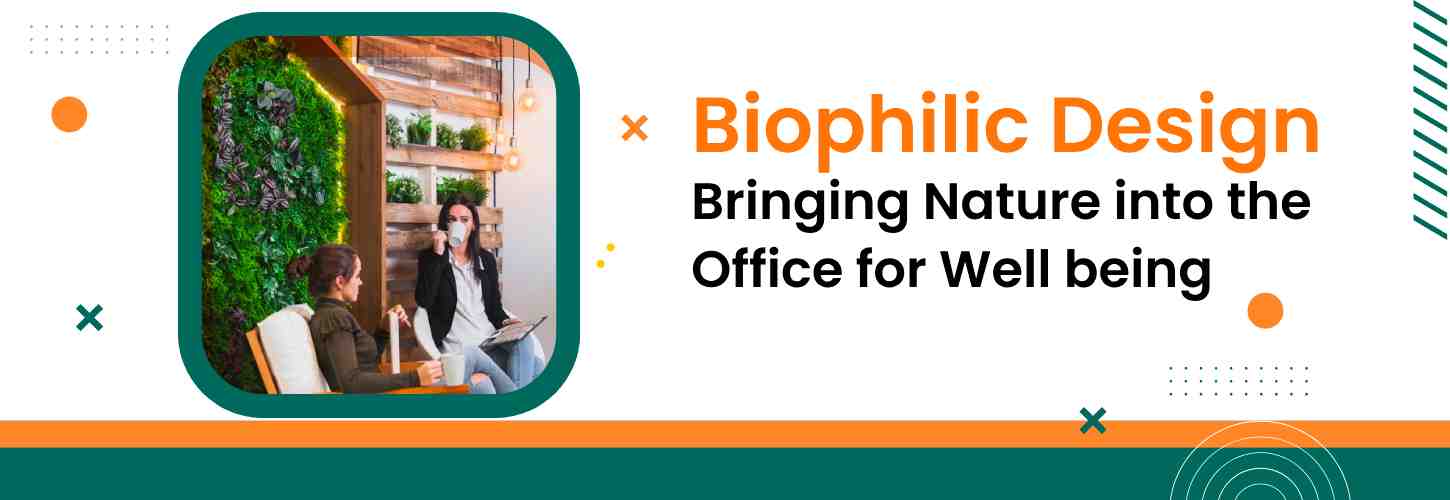In a fast-paced, technology-driven world, spending extended hours confined within office walls can lead to a sense of detachment from nature. Addressing this challenge is the emerging trend of biophilic design, which strives to close this gap by integrating natural elements into office spaces. Biophilic design acknowledges the intrinsic human affinity for nature and endeavors to establish environments that elevate well-being, productivity, and creativity. This blog post delves into the principles of biophilic design and examines the potential benefits it offers to both individuals and organizations.
What is Biophilic Design?
Derived from nature, biophilic design is an architectural and interior design strategy that incorporates natural materials, patterns, and elements into the constructed environment. The objective is to craft spaces that nurture a profound connection with the natural world, contributing to both physical and mental well-being.
Benefits of Biophilic Design in the Office
Improved Well-being
Exposure to natural elements has been linked to reduced stress levels, improved mood, and increased overall well-being. By incorporating biophilic design elements, offices can provide a more nurturing and healthful environment for employees, leading to better job satisfaction and overall happiness.
Enhanced Productivity and Creativity
Biophilic design has been shown to enhance cognitive function, concentration, and creativity. Employees surrounded by natural elements tend to experience improved focus and mental clarity, resulting in higher productivity and innovation levels.
Increased Employee Engagement and Retention
Creating an office environment that prioritises employee well-being and connection with nature can boost engagement and retention rates. Employees who feel cared for and connected to their surroundings are more likely to be loyal to their organisation, leading to reduced turnover.
Health Benefits
Biophilic design elements such as improved air quality, increased natural light, and access to green spaces contribute to better physical health. Reduced sick days, improved sleep quality, and increased vitality are just a few of the health benefits associated with biophilic design.
Embracing the power of biophilia
Incorporating biophilic design principles into office spaces offers numerous benefits to both employees and organisations. By introducing natural elements, such as light, plants, water features, and natural materials, offices can create environments that enhance well-being and productivity.
Ready for happier, healthier, and more engaged employees? Let us embrace the power of biophilia and create offices that not only foster productivity but also nurture the well-being of individuals within them.
Benefits of Biophilia for Individuals
The acknowledgment of our inherent human inclination towards the natural world has given rise to a discipline known as biophilia or biophilic design—a design ethos inspired by nature. The biophilia principle posits that individuals are instinctively attracted to nature for their well-being, and ongoing research indicates numerous advantages when organizations incorporate natural elements into their workplaces.
Beyond vegetation, various biophilic components, such as natural lighting, materials like wood and stone, patterns, colors inspired by nature, and views of water and wildlife, offer both physical and psychological benefit.
Benefits of Biophilia for Organizations
Beyond the positive impacts on individual well-being, studies indicate that introducing natural elements into the office setting can also yield organizational benefits. According to Steelcase researchers, the inclusion of nature stands out as a significant advantage that can contribute to overall health improvements in the workplace.
Key Principles & Elements
Natural Light: Maximizing access to natural light helps create a more comfortable and stimulating workspace. Large windows, skylights, and other strategies can be employed to bring in daylight, reducing reliance on artificial lighting.
Indoor Plants: Incorporating living plants into the office environment is a fundamental aspect of biophilic design. Plants not only improve air quality but also contribute to a sense of nature within the workspace.
Natural Materials: Using materials such as wood, stone, and other natural elements in furnishings and finishes can evoke a sense of the outdoors. These materials are often more sustainable and environmentally friendly as well.
Views of Nature: Providing views of nature, such as greenery, water features, or natural landscapes, can have a positive impact on employee well-being. Access to outdoor spaces, like balconies or terraces, further promotes a connection with the natural environment.
Biomorphic Forms and Patterns: Incorporating natural shapes, curves, and patterns in design elements can create a more visually appealing and calming atmosphere. This might include furniture with organic shapes or decorative elements inspired by nature.
Water Features: Incorporating water elements, such as fountains or indoor water features, can have a soothing effect and contribute to a calming atmosphere within the office.
Flexible Spaces: Creating spaces that are flexible and dynamic, accommodating movement and interaction, can replicate the changing nature of outdoor environments. This could involve incorporating collaborative zones, lounge areas, and workstations that can be easily adapted.
In Conclusion
In summary, biophilic design transcends being a mere trend; it represents a transformative approach to crafting healthier and more inspiring workspaces. By incorporating elements like plants, office facilities managers can enhance employee well-being, elevate productivity, reduce absenteeism, attract top talent, and improve the overall brand image of their organization. As our indoor lifestyles persist, the imperative for biophilic design has never been more crucial. Embracing the therapeutic influence of nature in your office can lead to a thriving workplace.
The fundamental objective of biophilic design is to establish environments that nurture the well-being, productivity, and creativity of individuals by fostering a connection with the natural world. Recognizing the profound impact of the built environment on our physical and mental health, this approach strives to shape spaces that cultivate a harmonious relationship with nature.
Contact Us
Kindly call our Experts @ +91 8121563728 / +91 8015527650 or mail us @ kalyan.r@greenworldsafety.com / indumanasa.m@greenwgroup.com
Get Your Query Answered / Get Expert Assistance To Choose the Right Course for You Or Your Associates






